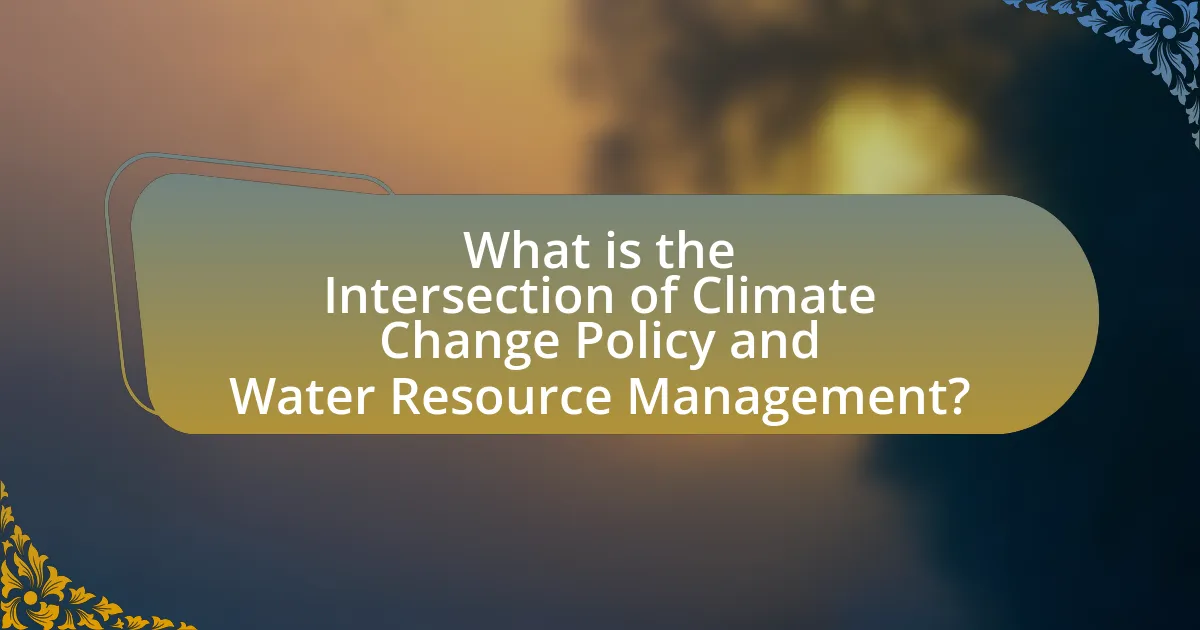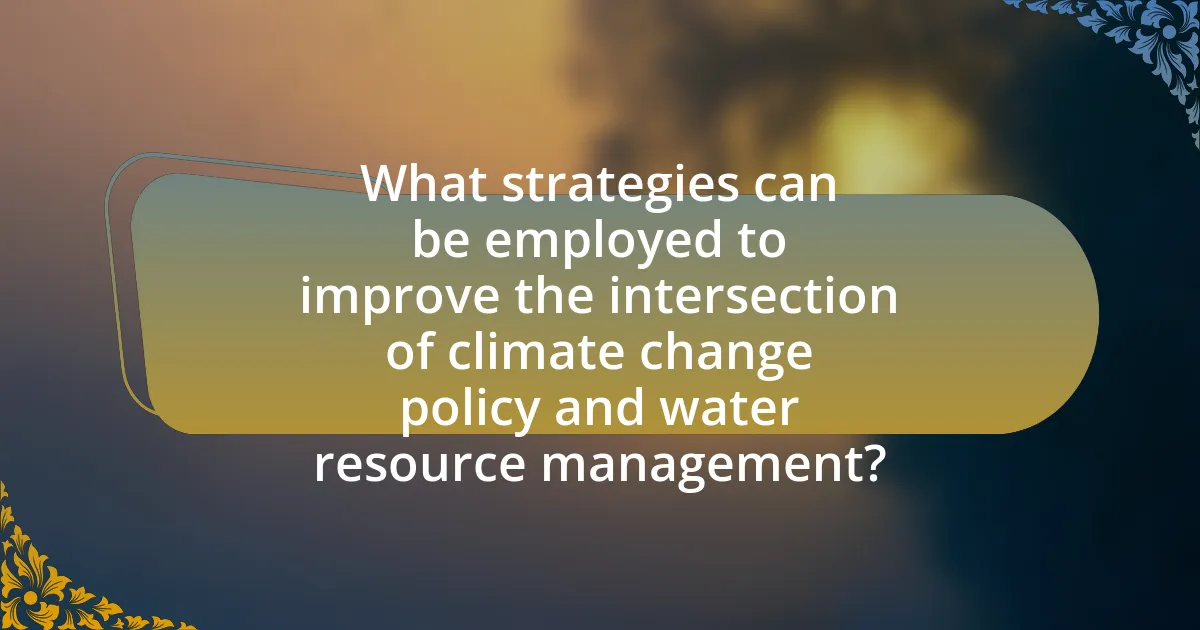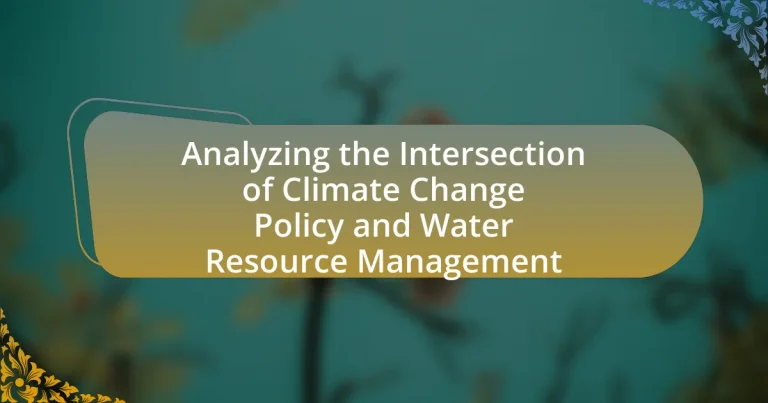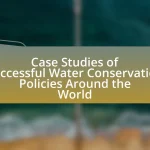The article analyzes the intersection of climate change policy and water resource management, emphasizing the need for integrated strategies to address the impacts of climate change on water availability and quality. It discusses how climate change policies influence water management practices, highlighting specific regulations such as the Clean Water Act and the Safe Drinking Water Act. The article also examines the challenges faced by policymakers, including water scarcity and the effects of extreme weather events, while proposing solutions such as adaptive management and stakeholder collaboration. Additionally, it underscores the importance of engaging local communities and utilizing technology to enhance water management outcomes in the context of climate change.

What is the Intersection of Climate Change Policy and Water Resource Management?
The intersection of climate change policy and water resource management involves the integration of strategies to address the impacts of climate change on water availability and quality. Climate change policies aim to mitigate greenhouse gas emissions and adapt to changing climate conditions, which directly affect hydrological cycles, leading to altered precipitation patterns, increased frequency of droughts, and flooding. Effective water resource management is essential for ensuring sustainable water supply, protecting ecosystems, and enhancing resilience against climate-related impacts. For instance, the United Nations Framework Convention on Climate Change emphasizes the need for adaptive water management practices to cope with climate variability, highlighting that approximately 70% of global freshwater is used for agriculture, which is highly sensitive to climate change.
How do climate change policies impact water resource management?
Climate change policies significantly impact water resource management by promoting sustainable practices and regulatory frameworks that address water scarcity and quality issues. These policies often include measures to reduce greenhouse gas emissions, which can mitigate climate-related impacts such as droughts and floods that directly affect water availability. For instance, the implementation of the Clean Water Act in the United States has led to improved water quality standards, which are essential for managing water resources effectively in the face of climate change. Additionally, policies that encourage water conservation and the development of infrastructure for rainwater harvesting can enhance resilience against climate variability, ensuring a more reliable water supply.
What specific policies are influencing water resources?
Specific policies influencing water resources include the Clean Water Act, which regulates discharges of pollutants into U.S. waters, and the Safe Drinking Water Act, which sets standards for drinking water quality. Additionally, integrated water resource management (IWRM) policies promote the coordinated development and management of water, land, and related resources. These policies are essential for addressing the impacts of climate change on water availability and quality, as they aim to enhance resilience and sustainability in water resource management. For instance, the European Union’s Water Framework Directive mandates member states to achieve good water status for all water bodies, directly influencing water management practices.
How do these policies address water scarcity issues?
These policies address water scarcity issues by implementing sustainable water management practices and promoting conservation efforts. For instance, regulations may include restrictions on water usage during drought periods, incentivizing the adoption of water-efficient technologies, and enhancing infrastructure for rainwater harvesting. Evidence from various regions shows that such policies can lead to a significant reduction in water consumption; for example, California’s water conservation measures during the 2012-2016 drought resulted in a 25% decrease in urban water use. Additionally, integrating climate change adaptation strategies into water resource management ensures that policies remain effective in the face of changing weather patterns, thereby mitigating the impacts of water scarcity.
Why is it important to analyze this intersection?
Analyzing the intersection of climate change policy and water resource management is crucial because it directly impacts the sustainability of water resources in the face of climate variability. Effective management of water resources is essential for ensuring water availability, quality, and ecosystem health, which are all threatened by climate change. Studies indicate that climate change can exacerbate water scarcity, alter precipitation patterns, and increase the frequency of extreme weather events, thereby affecting both human populations and natural ecosystems. For instance, the Intergovernmental Panel on Climate Change (IPCC) reports that regions already facing water stress will experience more severe impacts, necessitating integrated policies that address both climate adaptation and water management. This intersection is vital for developing resilient strategies that safeguard water resources while mitigating the effects of climate change.
What are the potential consequences of neglecting this analysis?
Neglecting the analysis of the intersection of climate change policy and water resource management can lead to severe consequences, including water scarcity, ecosystem degradation, and increased vulnerability to climate impacts. Without this analysis, policymakers may fail to implement effective strategies that address the interconnected challenges of climate change and water management, resulting in inefficient resource allocation and heightened competition for water. For instance, the United Nations has reported that by 2025, 1.8 billion people will live in areas with absolute water scarcity, emphasizing the critical need for integrated approaches that consider climate impacts on water resources.
How can this analysis contribute to sustainable development?
This analysis can contribute to sustainable development by identifying synergies between climate change policy and water resource management, leading to more effective resource allocation and policy implementation. By examining how climate change impacts water availability and quality, the analysis provides insights that can inform adaptive management strategies, ensuring that water resources are used efficiently and sustainably. For instance, integrated approaches that consider both climate resilience and water conservation can enhance agricultural productivity while reducing environmental degradation, as evidenced by studies showing that sustainable water management practices can increase crop yields by up to 30% in arid regions.

What are the key challenges at the intersection of climate change policy and water resource management?
The key challenges at the intersection of climate change policy and water resource management include water scarcity, the impact of extreme weather events, and the need for integrated governance. Water scarcity is exacerbated by climate change, with projections indicating that by 2025, two-thirds of the global population may face water-stressed conditions. Extreme weather events, such as floods and droughts, disrupt water supply and quality, complicating management efforts. Additionally, the lack of cohesive governance frameworks often leads to fragmented policies that fail to address the interconnected nature of climate and water issues, as highlighted in the United Nations’ 2021 report on climate adaptation.
What are the main obstacles faced by policymakers?
Policymakers face several main obstacles, including conflicting interests among stakeholders, limited financial resources, and insufficient data for informed decision-making. Conflicting interests arise when various groups, such as environmental advocates, industry representatives, and local communities, prioritize different outcomes, complicating consensus-building. Limited financial resources hinder the implementation of comprehensive climate change initiatives and water management strategies, as governments often operate under budget constraints. Additionally, insufficient data on climate impacts and water resource availability impedes effective policy formulation, as accurate information is crucial for assessing risks and developing adaptive measures.
How does climate variability affect water availability?
Climate variability significantly affects water availability by altering precipitation patterns and increasing evaporation rates. For instance, regions experiencing prolonged droughts may see a substantial decrease in surface water and groundwater supplies, while areas with intense rainfall may face flooding, leading to runoff that does not contribute to water storage. According to the Intergovernmental Panel on Climate Change (IPCC), climate change is projected to increase the frequency and intensity of extreme weather events, which can disrupt the hydrological cycle and impact water resource management strategies. This variability necessitates adaptive policies to ensure sustainable water availability in the face of changing climatic conditions.
What role do economic factors play in these challenges?
Economic factors significantly influence the challenges at the intersection of climate change policy and water resource management. These factors determine the allocation of financial resources for infrastructure development, technology adoption, and conservation efforts. For instance, limited funding can hinder the implementation of sustainable water management practices, exacerbating water scarcity issues. Additionally, economic incentives or disincentives, such as subsidies for water-intensive crops, can lead to inefficient water use and increased pressure on water resources. Studies show that countries with robust economic frameworks are better equipped to invest in adaptive measures, thereby mitigating the adverse effects of climate change on water systems.
How do social factors influence water resource management in the context of climate change?
Social factors significantly influence water resource management in the context of climate change by shaping community priorities, governance structures, and resource allocation. For instance, public perception of climate risks can drive local policies that prioritize sustainable water practices, as seen in regions where community engagement has led to the implementation of water conservation programs. Additionally, social equity issues affect access to water resources; marginalized communities often face greater vulnerabilities to climate impacts, necessitating targeted management strategies to ensure fair distribution and resilience. Research indicates that inclusive decision-making processes enhance the effectiveness of water management policies, as demonstrated by case studies in various countries where stakeholder participation has improved outcomes in water sustainability amidst climate challenges.
What are the implications for vulnerable communities?
The implications for vulnerable communities in the context of climate change policy and water resource management are significant, as these communities often face heightened risks due to environmental changes. Vulnerable communities typically experience limited access to clean water, increased exposure to extreme weather events, and inadequate infrastructure, which exacerbates their susceptibility to climate impacts. For instance, according to the Intergovernmental Panel on Climate Change (IPCC), regions with high poverty levels are more likely to suffer from water scarcity and flooding, leading to food insecurity and health crises. This intersection of climate change and water management policies can result in further marginalization of these communities if their specific needs are not addressed in policy frameworks.
How can public awareness and education improve outcomes?
Public awareness and education can significantly improve outcomes in climate change policy and water resource management by fostering informed decision-making and encouraging sustainable practices. When communities are educated about the impacts of climate change on water resources, they are more likely to engage in conservation efforts and support policies aimed at mitigating these effects. For instance, studies have shown that increased public awareness leads to higher participation rates in water-saving initiatives, such as rainwater harvesting and efficient irrigation techniques. Additionally, educational programs can empower individuals to advocate for policies that protect water resources, as evidenced by the success of campaigns that have resulted in legislative changes to improve water management practices.

What strategies can be employed to improve the intersection of climate change policy and water resource management?
Integrating adaptive management strategies is essential to improve the intersection of climate change policy and water resource management. Adaptive management allows for the continuous adjustment of policies based on observed outcomes and changing conditions, which is crucial given the unpredictable nature of climate change. For instance, the U.S. Environmental Protection Agency emphasizes the importance of incorporating climate projections into water management plans to enhance resilience against extreme weather events. Additionally, promoting stakeholder engagement ensures that local communities contribute to decision-making processes, leading to more effective and context-specific water management solutions. Research indicates that collaborative governance frameworks can significantly enhance the effectiveness of climate adaptation strategies in water resource management, as seen in case studies from various regions.
What best practices can be adopted for effective water management?
Effective water management can be achieved through practices such as implementing integrated water resource management (IWRM), promoting water conservation techniques, and utilizing advanced technologies for monitoring and distribution. IWRM facilitates the coordinated development and management of water, land, and related resources, ensuring sustainability and equity. Water conservation techniques, such as rainwater harvesting and xeriscaping, significantly reduce water usage and enhance resilience against droughts. Advanced technologies, including smart meters and remote sensing, improve efficiency in water distribution and usage, leading to better resource allocation. These practices are supported by studies indicating that IWRM can lead to a 20-30% increase in water use efficiency, thereby addressing the challenges posed by climate change on water resources.
How can integrated water resource management enhance policy effectiveness?
Integrated water resource management (IWRM) enhances policy effectiveness by promoting a holistic approach that considers the interconnectedness of water systems, ecosystems, and human activities. This comprehensive framework facilitates better decision-making by integrating various stakeholders, including government agencies, communities, and industries, ensuring that diverse perspectives and needs are addressed.
For instance, IWRM can lead to improved water quality and availability, which are critical for agricultural productivity and public health, thereby supporting climate change adaptation strategies. Research by the Global Water Partnership indicates that countries implementing IWRM have seen increased resilience to climate impacts, as coordinated management reduces conflicts over water resources and enhances sustainability.
What role does technology play in improving water management?
Technology plays a crucial role in improving water management by enhancing efficiency, monitoring, and data analysis. Advanced technologies such as remote sensing, IoT sensors, and data analytics enable real-time monitoring of water resources, allowing for better decision-making and resource allocation. For instance, the use of satellite imagery can track changes in water bodies and assess water quality, while IoT devices can provide continuous data on water usage and leakage detection. According to a report by the World Bank, implementing smart water management technologies can reduce water losses by up to 30%, demonstrating their effectiveness in optimizing water resources.
How can collaboration between stakeholders enhance outcomes?
Collaboration between stakeholders enhances outcomes by fostering shared knowledge, resources, and decision-making, which leads to more effective climate change policies and water resource management. When diverse stakeholders, such as government agencies, NGOs, and local communities, work together, they can identify common goals and leverage each other’s strengths. For instance, a study by the World Resources Institute found that collaborative governance in water management can improve water quality and availability, demonstrating that joint efforts lead to better resource allocation and sustainable practices. This collective approach not only addresses immediate challenges but also builds resilience against future climate impacts, ultimately resulting in more successful and sustainable outcomes.
What are the benefits of multi-sectoral partnerships?
Multi-sectoral partnerships enhance collaboration across different sectors, leading to more comprehensive solutions for complex issues like climate change and water resource management. These partnerships leverage diverse expertise, resources, and perspectives, resulting in innovative strategies that are more effective than isolated efforts. For instance, a study by the United Nations Development Programme highlights that multi-sectoral approaches can improve resource efficiency and foster sustainable practices, ultimately leading to better environmental outcomes. Additionally, such collaborations can mobilize funding and support from various stakeholders, increasing the overall impact of initiatives aimed at addressing climate-related challenges.
How can local communities be engaged in decision-making processes?
Local communities can be engaged in decision-making processes through participatory governance models that include public consultations, workshops, and collaborative planning sessions. These methods allow community members to voice their concerns, share local knowledge, and contribute to policy development, particularly in areas like climate change and water resource management. Research shows that when local communities are actively involved, the outcomes are more sustainable and reflective of the community’s needs, as evidenced by case studies in participatory budgeting initiatives where community input led to more effective allocation of resources.
What practical steps can be taken to address these challenges?
To address the challenges at the intersection of climate change policy and water resource management, implementing integrated water resource management (IWRM) is essential. IWRM promotes the coordinated development and management of water, land, and related resources to maximize economic and social welfare without compromising the sustainability of vital ecosystems.
Additionally, adopting climate-resilient agricultural practices can significantly reduce water usage and enhance crop yields under changing climate conditions. For instance, techniques such as drip irrigation and rainwater harvesting have been shown to improve water efficiency by up to 50% compared to traditional methods.
Furthermore, investing in infrastructure improvements, such as upgrading water supply systems and enhancing flood management capabilities, can mitigate the impacts of extreme weather events exacerbated by climate change. According to the World Bank, every dollar invested in disaster risk reduction can save up to seven dollars in recovery costs.
Lastly, fostering stakeholder engagement and collaboration among government agencies, local communities, and private sectors ensures that diverse perspectives are considered in water management strategies, leading to more effective and equitable solutions.
What are the key recommendations for policymakers?
Key recommendations for policymakers include integrating climate change considerations into water resource management strategies, promoting sustainable water use practices, and enhancing collaboration among stakeholders. Policymakers should prioritize the development of adaptive management frameworks that account for climate variability, as evidenced by studies indicating that regions implementing such frameworks experience improved resilience to water scarcity. Additionally, investing in infrastructure that supports water conservation and efficiency can lead to significant reductions in water waste, as demonstrated by successful initiatives in various countries. Finally, fostering public awareness and education on the impacts of climate change on water resources is crucial for community engagement and support for policy measures.
How can individuals contribute to better water resource management?
Individuals can contribute to better water resource management by adopting water-saving practices in their daily lives. Simple actions such as fixing leaks, using water-efficient appliances, and reducing water usage during activities like showering and lawn watering can significantly decrease overall water consumption. According to the U.S. Environmental Protection Agency, implementing water-efficient fixtures can save an average family about 20,000 gallons of water annually. Additionally, individuals can participate in local conservation efforts, such as tree planting and community clean-up events, which help maintain healthy watersheds. Engaging in advocacy for sustainable water policies at local and national levels also empowers individuals to influence water management practices.


